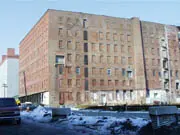WALDO a work in progress, Artists’ district on cusp of revival
Picasso might have called it the blue district, a scheme of languid colors that are all variations of the same.
Picasso might have called it the blue district, a scheme of languid colors that are all variations of the same. The WALDO district (Work And Live District Overlay), an eight-block area in Jersey City with rows of beaten-down brown warehouse buildings, is still indistinguishable four years after it was designated as a live/work community strictly for artists. But with a large warehouse in the district poised for conversion into artists’ lofts, the city, easel in hand, may soon see a colorful artists’ settlement.
In July of 1996, the Jersey City Municipal Council approved a zoning ordinance to establish WALDO. The district encompasses eight blocks between Marin and Washington Boulevards. Last summer, after members from the New Jersey Redevelopment Authority (NJRA) toured the district, the city was granted a $4 million loan from the NJRA for the acquisition of a warehouse at 110 First Street.
The seven-story, 210,000 square foot warehouse, located at the very end of First Street just before Washington Blvd., shields a mounting tide of newly-developed office and hotel buildings just a few blocks away. The tremendous building is the first project in the WALDO district set to undergo rehabilitation. Once completed, artists of various sorts would occupy rooms that could cost about $1,000 a month for 1,000 square feet of space with at least two-thirds to be used solely as workspace.
NJRA Finance Director David Scheck, who was among those who toured WALDO last year, said he was impressed with the area’s potential.
"I think we all believe that it’s an innovative approach to ensure that traffic comes down to Jersey City," he said, "and it has a lot of potential on paper."
The warehouse was expected to be ready for move-in by this coming fall, but construction has yet to begin. The project’s developer, Artists Housing Partnership of Brooklyn, was supposed to submit a site plan for rehabilitation of the building to the Jersey City Planning Board a few months ago but has yet to do so, Cotter said.
"They haven’t even come to the board yet," Cotter said, adding that he has no idea when the building will be ready for artists to move in.
David Judelson, a spokesperson for the Artists Housing Partnership, did not return calls.
An Artist Certification Board (ACB) was created by the city to screen people who want to live in this and other WALDO projects in order to ensure that they are bona fide artists. Charles Kessler, a Jersey City painter and member of the ACB, said 198 people have applied to live in the area. More than half, he said, currently live in Hudson County. The rest, he said, are coming "from Belgium, Massachusetts, the Bronx, Ohio, Manhattan, Vermont, other New Jersey [counties], Washington D.C., and California. The demand for space is phenomenal."
The ACB’s definition of an artist is "A person regularly engaged in fine arts as a career and not as a hobby. An artist is committed to his or her work, has a body of work that demonstrates the development of that art, and intends to pursue that work for the foreseeable future." The board also states that art created by artists need not be their main source for income. The ACB reviews applicants’ artwork completed in the last five years
Robert Cotter, director of the city’s Planning Board, said a group of working artists headed by Kessler came up with the idea to create the district. Kessler is president of Pro Arts, a non-profit visual arts organization.
"We looked at it, and we thought it was a pretty good idea," said Cotter. "The warehouse district was attractive for this kind of use. It made perfect sense."
According to the city, not only will the residents of the area be restricted to artists, but retail establishments will be restricted to art-related businesses such as galleries and performance space.
